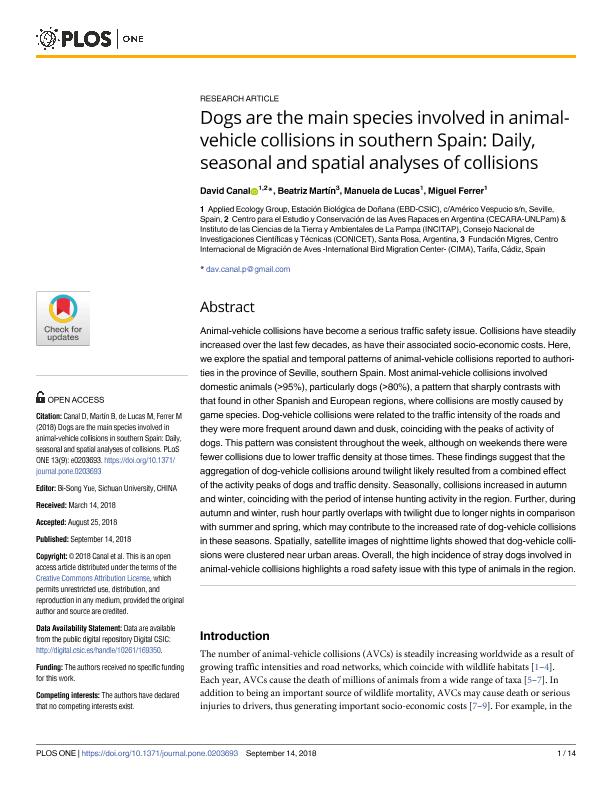Mostrar el registro sencillo del ítem
dc.contributor.author
Canal Piña, David

dc.contributor.author
Martín, Beatriz
dc.contributor.author
De Lucas, Manuela
dc.contributor.author
Ferrer, Miguel
dc.date.available
2020-08-31T20:54:03Z
dc.date.issued
2018-09
dc.identifier.citation
Canal Piña, David; Martín, Beatriz; De Lucas, Manuela; Ferrer, Miguel; Dogs are the main species involved in animalvehicle collisions in southern Spain: Daily, seasonal and spatial analyses of collisions; Public Library of Science; Plos One; 13; 9; 9-2018; 1-14
dc.identifier.issn
1932-6203
dc.identifier.uri
http://hdl.handle.net/11336/112838
dc.description.abstract
Animal-vehicle collisions have become a serious traffic safety issue. Collisions have steadily increased over the last few decades, as have their associated socio-economic costs. Here, we explore the spatial and temporal patterns of animal-vehicle collisions reported to authorities in the province of Seville, southern Spain. Most animal-vehicle collisions involved domestic animals (>95%), particularly dogs (>80%), a pattern that sharply contrasts with that found in other Spanish and European regions, where collisions are mostly caused by game species. Dog-vehicle collisions were related to the traffic intensity of the roads and they were more frequent around dawn and dusk, coinciding with the peaks of activity of dogs. This pattern was consistent throughout the week, although on weekends there were fewer collisions due to lower traffic density at those times. These findings suggest that the aggregation of dog-vehicle collisions around twilight likely resulted from a combined effect of the activity peaks of dogs and traffic density. Seasonally, collisions increased in autumn and winter, coinciding with the period of intense hunting activity in the region. Further, during autumn and winter, rush hour partly overlaps with twilight due to longer nights in comparison with summer and spring, which may contribute to the increased rate of dog-vehicle collisions in these seasons. Spatially, satellite images of nighttime lights showed that dog-vehicle collisions were clustered near urban areas. Overall, the high incidence of stray dogs involved in animal-vehicle collisions highlights a road safety issue with this type of animals in the region.
dc.format
application/pdf
dc.language.iso
eng
dc.publisher
Public Library of Science

dc.rights
info:eu-repo/semantics/openAccess
dc.rights.uri
https://creativecommons.org/licenses/by-nc-sa/2.5/ar/
dc.subject
Wildlife vehicle collisions
dc.subject
stray dogs
dc.subject
road mortality
dc.subject
domestic animals
dc.subject
collision hotspots
dc.subject
mitigation measures
dc.subject
non-natural mortality
dc.subject.classification
Conservación de la Biodiversidad

dc.subject.classification
Ciencias Biológicas

dc.subject.classification
CIENCIAS NATURALES Y EXACTAS

dc.title
Dogs are the main species involved in animalvehicle collisions in southern Spain: Daily, seasonal and spatial analyses of collisions
dc.type
info:eu-repo/semantics/article
dc.type
info:ar-repo/semantics/artículo
dc.type
info:eu-repo/semantics/publishedVersion
dc.date.updated
2020-05-04T20:51:49Z
dc.journal.volume
13
dc.journal.number
9
dc.journal.pagination
1-14
dc.journal.pais
Estados Unidos

dc.journal.ciudad
San Francisco
dc.description.fil
Fil: Canal Piña, David. Consejo Superior de Investigaciones Científicas. Estación Biológica de Doñana; España. Consejo Nacional de Investigaciones Científicas y Técnicas. Instituto de Ciencias de la Tierra y Ambientales de La Pampa. Universidad Nacional de La Pampa. Facultad de Ciencias Exactas y Naturales. Instituto de Ciencias de la Tierra y Ambientales de La Pampa; Argentina
dc.description.fil
Fil: Martín, Beatriz. Centro Internacional de Migración de Aves; España
dc.description.fil
Fil: De Lucas, Manuela. Consejo Superior de Investigaciones Científicas. Estación Biológica de Doñana; España
dc.description.fil
Fil: Ferrer, Miguel. Consejo Superior de Investigaciones Científicas. Estación Biológica de Doñana; España
dc.journal.title
Plos One

dc.relation.alternativeid
info:eu-repo/semantics/altIdentifier/url/https://journals.plos.org/plosone/article?id=10.1371/journal.pone.0203693
dc.relation.alternativeid
info:eu-repo/semantics/altIdentifier/doi/http://dx.doi.org/10.1371/journal.pone.0203693
Archivos asociados
